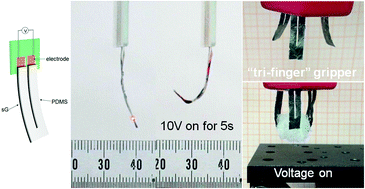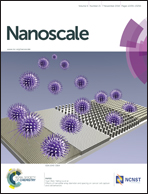A spongy graphene based bimorph actuator with ultra-large displacement towards biomimetic application†
Abstract
Bimorph actuators, consisting of two layers with asymmetric expansion and generating bending displacement, have been widely researched. Their actuation performances greatly rely on the difference of coefficients of thermal expansion (CTE) between the two material layers. Here, by introducing a spongy graphene (sG) paper with a large negative CTE as well as high electrical-to-thermal properties, an electromechanical sG/PDMS bimorph actuator is designed and fabricated, showing an ultra-large bending displacement output under low voltage stimulation (curvature of about 1.2 cm−1 at 10 V for 3 s), a high displacement-to-length ratio (∼0.79), and vibration motion at AC voltage (up to 10 Hz), which is much larger and faster than that of the other electromechanical bimorph actuators. Based on the sG/PDMS bimorph serving as the “finger”, a mechanical gripper is constructed to realize the fast manipulation of the objects under 0.1 Hz square wave voltage stimulation (0–8 V). The designed bimorph actuator coupled with ultra-large bending displacement, low driven voltage, and the ease of fabrication may open up substantial possibilities for the utilization of electromechanical actuators in practical biomimetic device applications.


 Please wait while we load your content...
Please wait while we load your content...